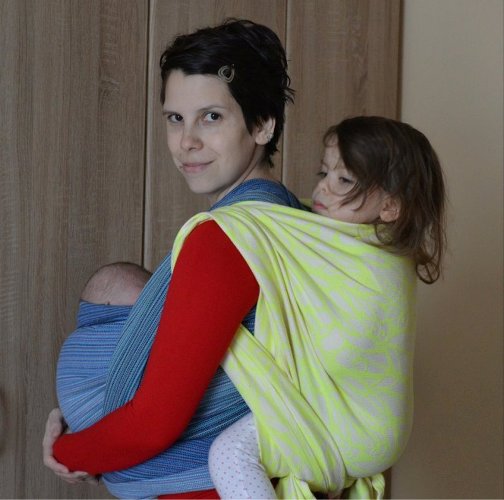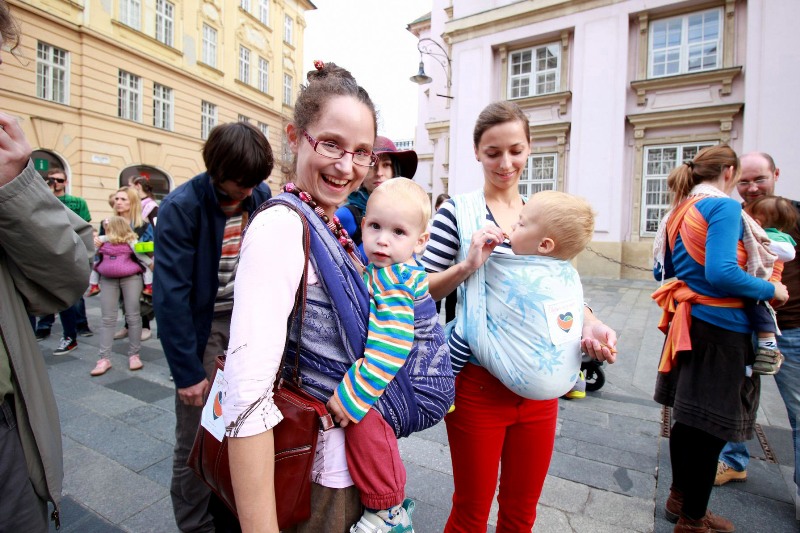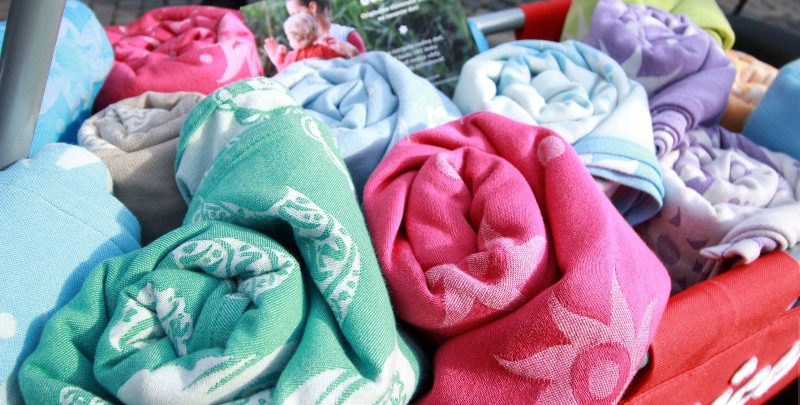For the fourth year in a row, parents will go out into the streets to celebrate and support the idea of babywearing. It’s all a part of the International Babywearing Week. This year, it will take place between the 2nd and 8th of October. Babywearing isn’t just a modern trend but it’s also a part of so-called attachment parenting that has been growing in popularity. We’ve talked about the topic of babywearing, moms and children with Jana Felcanová, the founder of Chcem nosiť, a Slovak civic association dedicated to babywearing.

Hi, Janka, I’d like to start with a basic question – why should we ‘wear’ our children? Why is wearing good for our child?
‘Wearing’ your children like this is a natural continuation of their development that started in the womb. There, children get used to being carried, so you don’t need to teach them – they already know :-). They had spent nine months of their development in there and they’re used to constant rocking, food on demand, warmth, and a constant connection to one person. Nine months. Should all of this change so suddenly after birth? The whole process of birth is a new and very stressful ordeal for them already and after it, they need some time to calm. They simply need to have everything as before and when they’re ready, they’ll stop requesting it on their own.
What about the mom? What does wearing mean for them?
Mothers will build a stronger and faster bond with their babies and quickly learn to understand their needs. It also helps to improve the mother’s mental state during the postnatal period when all the hormones usually go crazy. Oxytocin, the so-called happy hormone or love hormone, is produced when the mom is in contact with her baby, which can help with the stressful postnatal phase. The mom also has more control. She can feel her baby’s breathing (or if the breathing stops) and she can care for the household a lot more effectively because she doesn’t have to spend hours trying to put the baby to sleep or breastfeeding it. She can do all of these things while continuing her normal daily activities. She’s far less restricted by her own baby.
Is babywearing strictly a thing between the mom and her baby or do we need to include our partner, too?
The main idea behind babywearing is to provide contact and safety. This doesn’t necessarily have to be provided through wraps or scarves, we can find other ways to give our baby the contact it needs. These tools make our lives easier, though, and help us do our everyday business while having the baby with us. Of course, the baby also builds a bond with its father and its close family, too. It’s amazing to see the family getting involved in wearing :-). Of course, only when the baby doesn’t specifically ask for its mother, when it’s hungry or when it wants to sleep.
Can babywearing be combined with using a stroller or does a mom have to decide between one or the other?
That depends on the mother and her needs. What’s important is that the baby gets its needs fulfilled and this includes not only food and sleep but also contact. Wearing and the entire idea behind attachment parenting are about creativity and searching for solutions. Every mom is different, an individual, as well as their children. What is good for one person doesn’t have to be good for another. Some babies are almost impossible to put down because they require constant contact, while some babies need more help to fall asleep. It’s usually a rule, however, that every baby needs more contact during the first months of its life.
If the baby shows signs that its need for contact has been filled and the mom needs a little time off, there’s no reason not to use other tools, for example, to put the baby into bed or into a crib. The mom should never wear her baby if she’s not happy about it. The child can feel it. It’s always better to find some way to satisfy both and make sure that the needs of both are fulfilled.
How old should the baby be for babywearing? Is it good for newborns?
The development of a baby’s spine continues even after it’s born. It’s unnatural to try and forcefully straighten it because, at the beginning of a baby’s life, the spine is flexible and adjusts to the environment. To put it simply, the C shape of the spine changes into the regular S shape through the baby’s natural development. When the baby begins to hold its head up on its own, it creates the first bend. When the baby sits up by itself, it creates the second one. When it stands up, it creates the third. This is why babies shouldn’t be made to sit up before they’re ready or made to stand up by forcefully holding their arms. If the spine isn’t ready, we can do it harm. In an ergonomic physiological position, the baby has its head against the person carrying it and the spine is only being pushed against in a kangaroo carry when the baby tries to sit up straight. Wearing helps the baby’s mental development, the correct development of their joints, and helps prevent baby colic because the placement of the baby’s knees while being carried and the constant movement of the carrying parent are beneficial for its intestinal peristalsis.

There are many different tools to help carry a baby. What should a mother choose and what are the main differences between these babywearing tools?
When it comes to scarves, we know many kinds of different weights, materials, methods of weaving, places and ways of weaving, lengths, and widths. Their prices depend on all of these factors. It’s generally true that we can use something as simple as a normal sheet to carry a baby. The important thing it how you carry your child, not what you carry it in.
It’s a bit different with carriers. They also come in many different kinds and brands, but the market also offers so-called kangaroo carries that don’t really support healthy babywearing. They help maintain contact, but they cause discomfort to both the baby and the mom.
Healthy ergonomic carrying is the kind of babywearing that continues the baby’s development as it used to be in the womb. The baby was curled up with its knees bent almost under its chin, arms around the knees, and the back was curved. This is how it should look while carrying in a scarf or carrier. This is why ergonomic carriers have a wide space between the baby’s legs – to put the knees farther apart and lift them higher than the backside. In this position, the baby’s back becomes rounded. The back of the carrier always needs to accommodate this round shape well and be able to adjust to it – it can’t be too firm or padded.
How can we tell the difference between a kangaroo carrier and an ergonomic carrier? Why is the kangaroo carrier worse?
Kangaroo carriers have a very narrow area between the baby’s legs – about as thick as regular underwear, which makes the legs literally dangle down, pulled by gravity. This is bad for the baby’s joints and it also causes the baby to hang by its genitals, which is very uncomfortable – try to hang by your underwear and see how it feels :-). They also usually have a padded backrest which forces the baby to sit straight and puts a bit of a distance between it and the person carrying it. In such a position, the baby’s head pushes down on the spine. This can’t happen with ergonomic carriers because of the rounded shape which helps the baby rest its head on the person carrying it and when the baby can lift its head up on its own, it won’t push against the spine.
Another way to tell apart a kangaroo wrap is the absence of a waist strap. This causes discomfort to the babywearing person because the entire weight literally hangs on their shoulders. The weight is not distributed properly, so they can’t carry the baby for a long time or risk damaging or hurting their back. Kangaroo carriers are also a lot cheaper than ergonomic carriers.
Kangaroo carriers often tend to present a way of carrying the baby while it’s facing away from the person carrying it. This isn’t healthy for the baby because it doesn’t have the option to hide away when faced with too many outer stimuli. It also forces them to sit up straight and prevents them from sitting in a flexed abducted position – with its knees higher than its bottom.

Moms often don’t know how to properly carry their baby. Where can a mom turn if she wants to start with babywearing but doesn’t know how to do it?
They should turn to a babywearing consultant, of course :-). There are many of them in Slovakia. They should always be careful, though, because consulting isn’t regulated in Slovakia. It’s good to always follow positive referrals or recommendations. The civic association Nosma is currently trying to put together a list of trusted consultants.
Some people still look at babywearing moms through their fingers. Especially in smaller towns, moms can encounter jabs and taunts. Do you often see such reactions to babywearing?
Sometimes it’s hard. Prejudice is often deeply rooted inside of people and we often believe ‘100% true stories’ even if there is no evidence for it. Even a mom who chooses babywearing for herself can have doubts because of something someone told her before. Why? No real reason, just because. A great solution for such doubts is to create babywearing support groups. Two moms with the same kind of thinking, same kind of experiences and problems can get together and share. They can truly support each other. It often helps a lot to find out that you’re not alone in something :-). It’s easy to have doubts when your whole family keeps constantly debating whether or not you’re ruining your baby’s spine or suffocating it by carrying it like this. When you find out that other babywearing moms have the same problems, it becomes easier to handle. You laugh at it together and when your family starts to debate again, you just think back to your support group and smile.